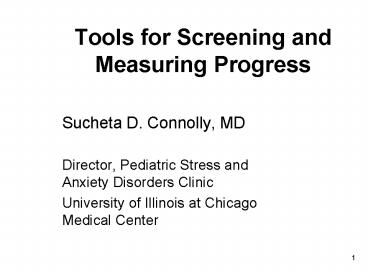Tools for Screening and Measuring Progress - PowerPoint PPT Presentation
Title:
Tools for Screening and Measuring Progress
Description:
Tools for Screening and Measuring Progress Sucheta D. Connolly, MD Director, Pediatric Stress and Anxiety Disorders Clinic University of Illinois at Chicago Medical ... – PowerPoint PPT presentation
Number of Views:48
Avg rating:3.0/5.0
Title: Tools for Screening and Measuring Progress
1
Tools for Screening and Measuring Progress
- Sucheta D. Connolly, MD
- Director, Pediatric Stress and Anxiety Disorders
Clinic - University of Illinois at Chicago Medical Center
1
2
Screening for Anxiety Disorders
- Childhood anxiety disorders are common and often
co-occur (8-10) - Routinely include screening for anxiety symptoms
as part of any child and adolescent evaluation - Obtain information from multiple informants
(child, parent, school)
2
3
Tools for Screening and Measuring Progress
Anxiety Disorders
- BASC CBCL broad band measures completed by
child, parent, and teacher - (parent teacher report for young children)
- Alternative Vanderbilt Assessment Scale
- (parent teacher report)
- Pediatric Symptom Checklist(parent/child)
- MASC (March et al., 1997) and SCARED (Birmaher
et al., 1999) anxiety self-report measures for 8
years and older - Sensitive to change treatment progress
- () available with open access on line
3
4
Tools for Screening and Measuring Progress
Comorbid Disorders
- CDI self-report for depression
- Conners parent teacher report for ADHD
(alternative Vanderbilt) - Both of these are sensitive to change treatment
progress - Screen for substance abuse (CRAFFT)
- Consider LD, language disorders, PDD
4
5
Adolescent Substance Abuse Screening CRAFFT
- Six-item measure that assesses for problematic
substance use among adolescents - This measure is very brief and can be given as a
standard part of an initial assessment to screen
for likelihood of a substance use disorder. - Two or more yes responses are suggestive of a
probable substance use disorder and should be
followed up with a more in-depth assessment.
5
6
Adolescent Substance Abuse Screening CRAFFT
- Have you ever ridden in a Car driven by someone
(including yourself) who was high or had been
using alcohol or drugs? - Do you ever use alcohol or drugs to Relax, feel
better about yourself, or fit in? - Do you ever use alcohol/drugs while you are by
yourself, Alone? - Do your Family or Friends ever tell you that you
should cut down on your drinking or drug use? - Do you ever Forget things you did while using
alcohol or drugs? - Have you gotten into Trouble while you were using
alcohol or drugs? - (Two or more yes answers suggests risk for
substance use disorder)
6
7
T-Scores And What They Mean
- Mean T-score 50
- Standard deviation (sd) 10
- T-scores from 40-60 Average range
- 65-70 Borderline significant (top 5)
- 70 or higher Clinically significant (top 2)
- T-scores 39 and below Low
- Do not need to be a clinician to score and
interpret these screening measures CBCL or BASC
(broad-band), MASC (anxiety), CDI (dep), Conners
(ADHD)
7
8
Selective Mutism Questionnaire (R. L. Bergman
Ph.D.)
- Parent report and teacher report
- Items relate to situations in school, with
family, in social situations outside school, and
other situations - Parents rate how often child interacts with
others - Behavior and interference ratings
- Research measure under development
8
9
Assessment of Anxiety Disorders
- ADIS-C
- Differential Diagnosis
- Severity and Impairment
9
10
Differential Diagnosis and Assessment of Anxiety
Disorders
- If screening indicates significant anxiety,
evaluate further for specific anxiety disorders - Distinguish from normal fears, worries, and
responses to stressors or trauma - Evaluate severity and functional impairment of
anxiety disorders and comorbid disorders - Consider differential diagnosis with other
psychiatric and medical disorders
10
11
ADIS-DSM-IV-Child Version
- ADIS-DSM-IV-Child Version (Silverman Albano,
1996) for youth 6-17 years old to supplement
clinical interview (parent and child interview
schedule) - Considered Gold Standard
- Feelings Thermometer to assess severity,
functional impairment (interference), and monitor
progress - Developmentally appropriate language and
situations that apply to youth - Assessment of commonly comorbid disorders (ADHD,
depression, dysthymia)
11
12
Differentiating Anxiety Disorders
- SAD
- GAD
- Social Phobia
- Specific Phobia
- Panic Disorder
- Selective mutism
- OCD
- PTSD
12
13
Differentiating from Physical Conditions
- Physical conditions with anxiety-like symptoms
hyperthyroidism, caffeinism (soda), migraine,
seizure disorders, lead intoxication,
pheochromocytoma, cardiac, etc. - Medication side effects prescription
(antiasthmatics, steroids, sympathomimetics) and
non-prescription drugs (cold medicines,
antihistamines) - Somatic symptoms commonly associated
(stomachaches, headaches), consider MHA early in
medical evaluation
13
14
Differential Dx Psychiatric
- Psychiatric conditions (similar symptoms)
- ADHD (restlessness, inattention)
- Psychotic disorders (restlessness, social
withdrawal) - PDD (social awkwardness, social communication
deficits, repetitive behaviors, adherence to
routines) - LD (worries about school performance)
- Bipolar disorder (restlessness, irritability,
insomnia) - Depression (poor concentration, sleep problems,
somatic complaints)
14
15
Tools to Assess and Monitor Severity and
Impairment
- Feelings Thermometer to assess severity,
functional impairment (interference), and monitor
progress - Feelings Barometer can include faces rather than
numbers, or link the two - Choose developmentally appropriate tool young
children may use 1-2-3 faces scale
15































